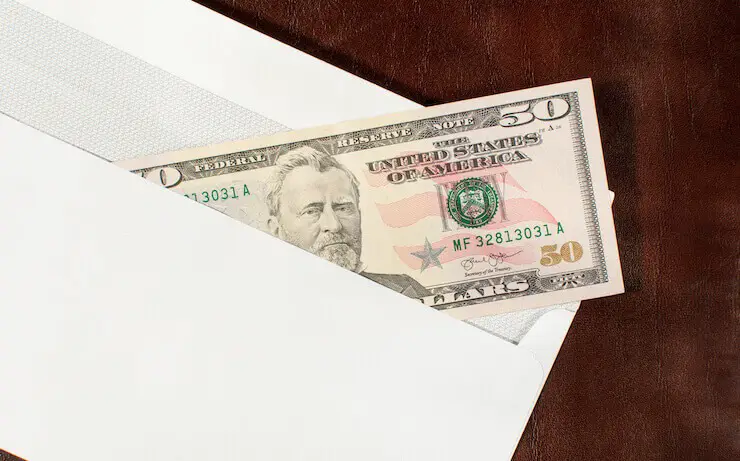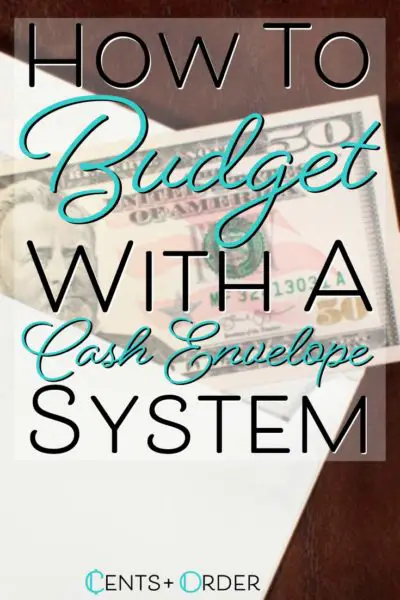Having a hard time getting your budget to work? Are you finding that each month you exceed your budget?
Budgeting problems is the number one concern of my readers, so you’re not alone. You’ve probably tried different ways to track your budget, from paper and pencil to a spreadsheet to a fancy app. And yet none of those options seem to solve your budgeting woes.
Even as a numbers girl, I hate tracking a budget. While I hate the tracking part, I understand that a budget serves an important purpose for your finances.
Your budget allows you to dictate where your money should go. Then you can evaluate your spending at the end of the month. What should you do if you find that you are having a hard time keeping your budget in check?
Table of Contents
Use a cash envelope system for trouble areas.
Whether you’ve kept a budget before or not, you should be able to determine your problem areas. We all have areas of spending that we have to work hard to keep under control. Grocery/food costs and entertainment/fun tend to be the most common trouble spots and that makes sense because these are all variable/discretionary expenses.
You don’t need to do cash for your fixed expenses, like your mortgage and your car insurance. Instead, focus on using the cash budgeting system for all your discretionary budget categories, or even the top 2 variable expenses that you have been struggling with the most.
Determine the budget for each category.
Once you’ve determined your problem areas, figure out what the budget should be. If this is your first budget, then start with how much you spent last month as your budget amount.
Get cash for each budget category.
For example, if you trouble category is food (with a $400 monthly budget) and entertainment (with a $100 monthly budget), withdraw those amounts in cash for your budget.
Divide your cash into individual envelopes.
Each category budget gets an envelope or divided in some way. I like to use the cash envelopes you get from the bank. You could also use regular envelopes or a coupon type organizer.
I’ve also seen this tutorial for making cash envelopes out of scrapbook paper. Sometimes having a pretty system of organization is just the motivation you need to stay on track.
That’s all you can spend on that category for the month. Once your envelope is empty, you can’t spend any more!
Why the cash envelope system works
When you use a debit card (or credit card) to make purchases, it’s easy to go over the amount you have budgeted.
By using a cash envelope system, you become more aware of what you are spending (and your spending limits).
For example, if you know that you only have $50 in your envelope left for groceries, you might keep track of how much you’ve put in your cart as you are walking through the grocery store.
Evaluate at the end of the month
Were you able to keep that spending category within your budget? Or did you still exceed your budgeted amount?
If you overspent, and find that you tend to always go over budget, then it may be time to reconsider your budgeted amount. Initially, your budget should reflect your real spending habits. You can always work on decreasing your spending in the coming months.
Potential Problems and Solutions
No system is perfect and the cash envelope system has its own set of potential drawbacks.
Below, we’ll discuss what those are and how you can overcome them (or at the very least, minimize them) to make the cash envelope system work best for you.
Complaint #1 – Carrying a roll of cash is a safety hazard.
When it comes to the list that people throw at me for why using cash envelopes won’t work for them, this complaint is usually always at the top. People just know that using a cash system will end up causing them to get mugged!
While I do think that some people may slightly overdramatize the safety risk of using cash, it is true that a big wad of cash can attract attention from the wrong people.
So what’s the solution to this problem? Honestly, the best solution is just to make sure that you follow the envelope system as it’s intended to be used by splitting your cash up among several different envelopes.
Instead, many people go wrong by only going halfway with the cash system. What I mean by going “halfway” is they withdraw the amount of cash that they will need to cover all their weekly expenses and then they just carry this one ginormous roll around town throughout the week.
But just using cash for purchases isn’t the same as using the envelope system.
If you have been struggling with spending discipline, is using cash better than using your credit card? Yes. But carrying one big wad of cash is not only a safety hazard, but it also defeats the whole purpose of the envelope system, which is to make sure that you are only spending what you’ve budgeted in each budgeting category.
To further break up how much cash you have on you at any given moment, only take the cash that you need from an envelope at any given time. In other words, instead of bringing your entire month’s grocery envelope with you to the store, just take out the amount of cash that you will need to buy all the groceries for that particular trip.
By implementing these strategies, you can greatly reduce any safety risk that carrying cash may pose for you and your family.
Complaint #2: I don’t have enough cash in the bank to fully fund my monthly cash envelopes.
If you aren’t able yet to fully fund your envelopes at the beginning of the month, that’s ok. You can still use the envelope system by withdrawing a portion of your total budgeted amount as you receive each paycheck.
For example, if you decide to create a $400 monthly budget for groceries, you could take out $100 from every weekly paycheck to put in your grocery envelope (or $200 with each paycheck if you are paid bi-weekly).
Hopefully, as you follow the system and get more disciplined with your spending, you’ll be able to build up enough cash reserves in your savings account that these cash flow issues will become less and less of a concern.
Complaint #3: The cash envelope system is more difficult for couples.
I often hear that the cash envelope system is much harder to follow for couples than it is for single individuals.
- One spouse’s car may run low on gas when the other spouse happens to have the gas envelope, for example.
- Similar examples could be given for groceries, clothing, and just about any other budget category.
While I completely understand that these types of situations could cause frustration, you can honestly avoid most of them by just trying to do a little bit of a better job of planning ahead.
- For example, I recommend trying to limit your grocery shopping to once or twice a week. This will force you to make a meal plan for the entire week before heading out to the store. Not only will this make it easier to stick with your cash envelope system but will likely save you money too!
- When it comes to gas, I would also pick a designated day of the week (or two) that you fill up all of your cars for the week. For us, we take care of both of these chores together on our day off but pick whatever works best for you.
And for sharing the envelopes on other expenses?
- Well, my wife pretty much takes care of all the clothes shopping in our relationship, so she keeps sole possession of that envelope.
- And for restaurants, we just about always eat out together anyway so we rarely run into the issue of one of us having the restaurant envelope when the other needs it.
So you see, with just a little bit of extra planning, the cash envelope system really doesn’t need to be something that becomes a huge hassle in your life.
How to Implement a Digital Version of the Cash Envelope System
Some of you have read all of my answers to the objections above and you still aren’t satisfied. For whatever reason, you may still have an aversion to using cash for your purchases.
Well, did you know that you can actually implement a digital version of the cash envelope system? Here’s how.
First, create a budget on paper or using your favorite budgeting software.
For homemade budgets, you can use Excel or Google Sheets. If you’re looking for an online budgeting tool that will connect with your debit card and automatically log your expenses, Mint, YNAB, EveryDollar, and Personal Capital are all great choices.
Second, create a separate checking account that will be used for only your discretionary expenses.
This account would be different than the checking account that you use for automatic withdrawals on car insurance, health insurance, mortgage, internet, and other fixed expenses.
Third, add all your discretionary expense budgets together and move that amount over to your separate checking account at the beginning of the month.
For example, if you budget $400 for groceries, $200 for gas, $100 for restaurants, and $50 for entertainment, then you would move a total of $750 over to this separate checking account.
Fourth, use your debit card for all your purchases.
Remember, the whole idea of the cash envelope system is to get runaway spending in check. This digital version can only be a true cash envelope replacement if you only use your debit card to pay for things.
If you cheat here and there and use your credit card for purchases, then this system will not work!
Keep your receipts so that you can log each transaction into your budget. Or, if you’ve connected your debit card to an online budgeting tool, you can view the transactions there and make sure that they’ve all been placed in the right budget category.
Finally, disable overdraft on your debit card.
Yes, you read that correctly. That way if you try to buy something when you don’t have cash in the account, you will not be able to complete the purchase.
Will this be a bit embarrassing? Sure. But better to deal with a little embarrassment from having your card declined then to deal with exorbitant fees. Banks love to charge customers for taking advantage of their overdraft “service.”
And remember, none of your bills like your mortgage or insurance are going to come out of this checking account anyway. You are only going to use this account for discretionary expenses.
At worst, disabling overdraft on this account may force you to take a couple of ice cream cartons or shirts and jeans out of your shopping cart. But it’s not going to cause you to neglect any of your important financial obligations.
Conclusion
Try using cash instead of your debit/credit card for the areas you struggle with the most in your budget. By using cash, you’ll be able to tangibly track your spending at a glance throughout the month.
Have you tried using the cash envelope system? If so, connect with us on Facebook or Twitter to let us know if the system was a hero (or just a hassle) for your own finances!


